by Editor | May 12, 2014 | Accomodations, Ecotourism, New Articles
Article and photos by Josette King
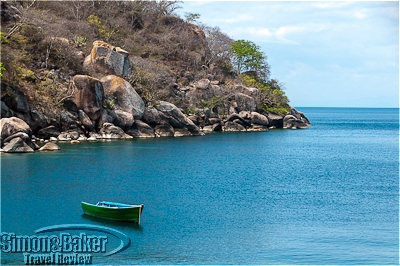
The view from my tent at Mumbo Island
When I first heard of Malawi, in the earliest days of my love affair with Africa over a decade ago, I confess that I had to consult an atlas to locate the small landlocked country wedged into the southern end of the East African Rift Valley. Less than 900 kilometers (560 miles) from north to south and barely 160 kilometers (100 miles) at its widest, Malawi was overshadowed by its much larger neighbors, Tanzania to the north, Zambia and Mozambique to the south, east and west. It was, and remains as of this writing, mainly unnoticed by international tourism travelers. Yet this narrow strip of rugged terrain carved by the Great Rift Valley is rich in spectacular vistas and home to several national parks, and of course Lake Malawi, known by the most passionate divers and water sports enthusiasts. It is the third largest of the African lakes, and for some arguably the most beautiful.
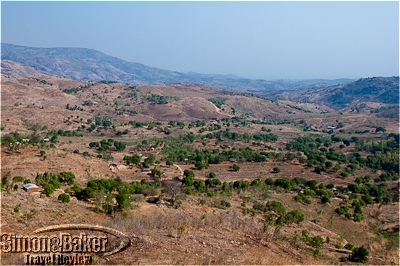
Great swaths of the country were used for subsistence agriculture
It is also one of the poorest countries in Africa, and one for whom the development of a viable tourism industry is an important growth and indeed survival factor. It was this opportunity to have it all, to visit, and through that support a country in the early stages of modern development as well as enjoy a safari off the beaten track, and experience a remote tropical beach environment known by many in the region, but rarely visited by international travelers, all within a few hours’ drive that made Malawi an irresistible destination for my most recent African visit.

The shores of Lake Malawi were dotted with fishing villages
Reaching Malawi had its challenges. With a population of 16 million living mainly in rural areas, and an economy largely based on subsistence agriculture, it is one the least developed countries in Africa, with only the most rudimentary national infrastructure. And what of the tourism infrastructure? I needn’t have worried. A few forward thinking properties have established themselves in recent years, ranging from unabashedly off the grid to luxury class, in the most desirable tourism destinations in the country. Each had a unique personality that was just right to ensure optimum enjoyment of it surroundings. One constant however, throughout my visit to the peaceful little country was the warm welcome of the gentle people of Malawi.
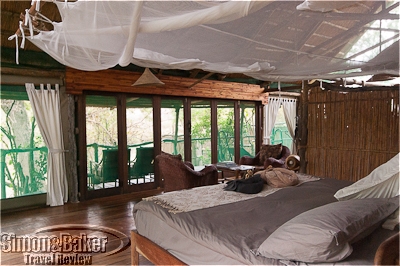
The king size bed at Mvuu faced the deck and the bush
From a luxury safari perspective, Malawi is for people who want a bit of real world authenticity with their posh African safari.
Mvuu Lodge in Liwonde National Park, considered the premier park in Malawi for its large population of hippos and elephants and its abundant bird life, offered intimate wilderness tented accommodations with a casual atmosphere and the creature comforts I have come to expect from a luxury safari property. Ideally located at the edge of a secluded lagoon across the Shire River from the park entrance, it could be reached only by boat. The open sided main area was raised high into the trees for a sweeping view of the constant wildlife activity along the lagoon. The riverside location allowed for a mix of cruises and drives that provided a close and varied view of the game as it went about its daily life. The highpoint of my stay was a perfect morning on the river, when we came across a bachelor herd of elephants, one of them sound asleep (yes, elephants can sleep laying down), then spent a memorable hour watching their antics as they horsed around in the middle of the river like teenagers at the beach.
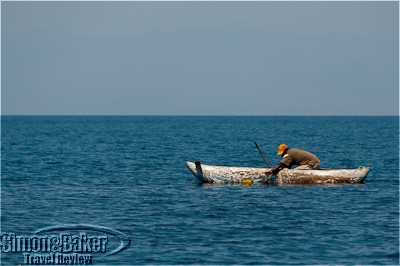
A local fisherman casting his net from a dugout canoe
Some 580 kilometer (360 mile) long, Lake Malawi is the main topographic icon of the country. It is internationally renowned among water sports enthusiasts and naturalists for its pristine shores and deserted islands nestled between towering boulders rising straight from crystal clear waters alive with small brightly colored fish. The beauty of the scenery and the hundreds of endemic species of cichlids fish drove the Malawi government to set aside the southern end the lake as Lake Malawi National Park in 1980. It was the first fresh water marine reserve in the world, and then in 1984 it became a UNESCO World Heritage Site.
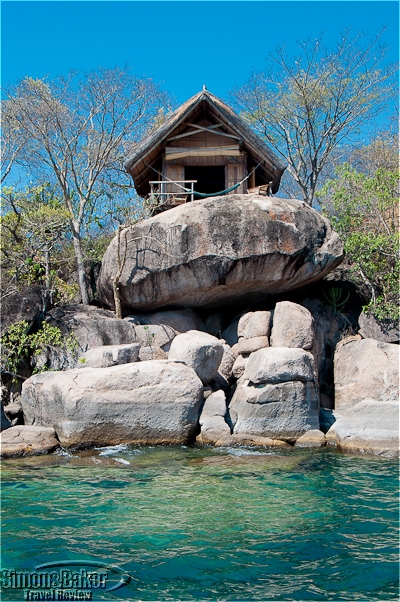
My tent was a reed and thatch bungalow high above the lake
An hour’s motorboat ride off shore from Cape Maclear, Mumbo Island was a pristine one square kilometer (250 acres) dot of granitic rock topped by lush miombo woodland and blessed with a crescent beach of golden sand. Until the National Parks authorities first awarded Kayak Africa the exclusive rights to operate tourism accommodations on the island in 1996, it had never been populated. To preserve its unspoiled beauty, Kayak Africa created Mumbo Island Camp, a minimalist property run on uncompromising sustainable principles. It consisted of rustic bungalows of reed and thatch with comfortable beds, bucket showers and “eco-loos,” perched high in the rocks to better admire the dazzling waters of the lake, a dining area that served wholesome, simple foods, and in a corner of the beach, a water sports gazebo. There was no electricity, just solar and paraffin lamps and wind up flashlights. What did I like best? The dawn wake up call of a red billed hornbill enthusiastically welcoming the sunrise, and snorkeling in warm waters so clear I could see the outlines of underwater boulders deep beneath me, bright cichlids darting about them, and kayak rides to watch the sun dip into the lake, and… well, everything. The ultimate luxury of Mumbo Island Camp was its very existence.
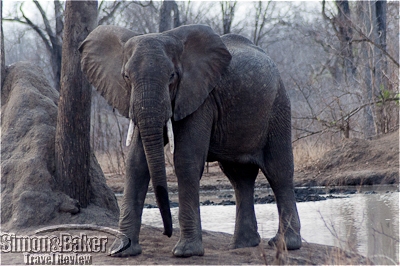
Elephants were a common sight at Mkulumadzi
Mkulumadzi, the sole property in Majete Game Reserve, the recently reborn only Big Five game park in Malawi on the Lower Shire River; and Pumulani, on the western side of the Nankumba Peninsula at the edge of the Lake Malawi National Park, were sister properties designed for Robin Pope Safaris by G. Hooft Graafland, a Dutch architect. These innovative world class luxury lodges sat gently upon the land, each guest accommodation custom designed to fit into the topographic elements of its environment, and covered with a roof of endemic vegetation to help offset its own carbon footprint and regulate inside temperatures.
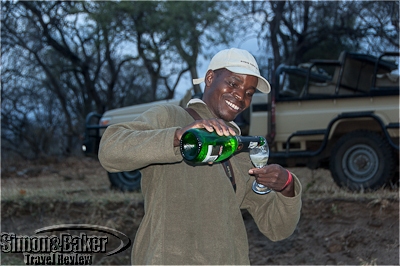
Samuel Chihana pours a sundowner drinks for us
While the properties had their distinct character best adapted to their purpose, both were decorated in an elegantly understated contemporary style that offered optimum comfort without ever distracting from their breathtaking surroundings. Each had its own trademark feature. At Mkulumadzi, the wilderness lodge, it was the impressively engineered 88 meter (290 foot) suspension foot bridge that led across the river to the property’s entrance. It never failed to deliver new game viewing opportunities and make me feel like an explorer of a bygone era.
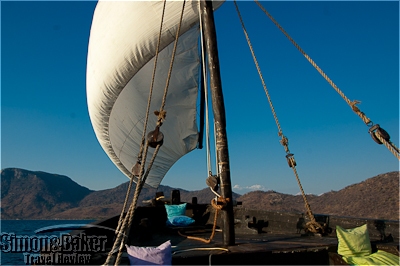
The traditional dhow sailed around the lake
At Pumulani, the lakeside beach lodge, the unique feature was the authentic, hand built wooden dhow with a triangular sail, reminiscent of the days when Arab traders plied the waters of the lake, always ready to take me on a breakfast or sunset cruise. And best of all, along with exceptional memories I took away the satisfaction to have experienced two properties in harmony with my responsible tourism ethos.
But that was no surprise. On one of my early visits to Zambia many years ago, I had the good fortune to meet Robin and Jo, the founders of Robin Pope Safaris. It was a conversation that went a long way to opening my mind to the power of responsible tourism as a tool for sustainable development in Africa and beyond.
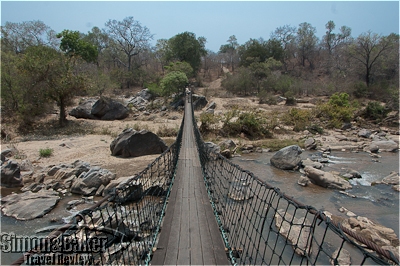
The lodge was reached via a suspension footbridge over the Mkulumadzi River
These two premier properties, relatively recently opened in a country still in the early stages of development were an ideal opportunity to experience first hand the contribution that the presence of my fellow tourists and I were making to the protection of previously at risk wilderness areas, while helping to alleviate poverty through good local employment practices, and the involvement of the local communities. I was delighted to hear that Pumulani was recognized as Malawi’s leading hotel at the 2011 and 2012 World Travel Awards.
by Editor | Mar 31, 2014 | Accomodations, Ecotourism
Photos by Josette King
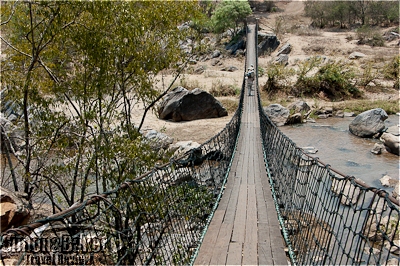
The lodge was reached via a suspension footbridge over the Mkulumadzi River
The recently restored Majete Wildlife Reserve in southern Malawi remains mostly undiscovered by tourists. Mkulumadzi offered accommodations within a 7,000 hectare (27 square mile) private concession with exclusive tourism rights in one the most spectacular areas of the repopulated wilderness area.
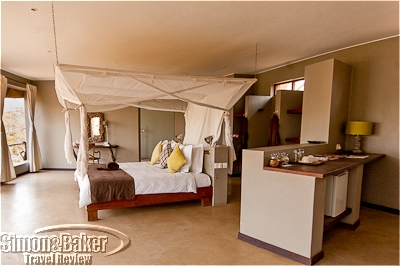
Josette’s room featured a well appointed pantry
Designed to minimize its impact on the environment while offering high levels of creature comforts, the property also focused on serving healthful, refined international dishes with a pan African accent. Beyond game viewing our contributor especially appreciated Mkulumadzi’s responsible tourism practices and guest centered service.
by Editor | Jan 13, 2014 | Accomodations, Luxury Travel, New Articles
Article and photos by Josette King
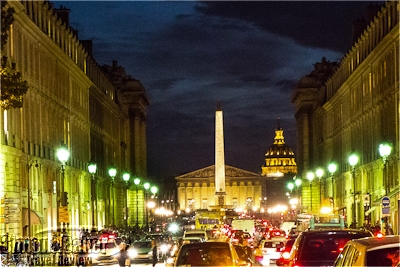
Rue Royale and Place de la Concorde at night.
Although I am a regular visitor to Paris, it had been years since I had set foot around the Rue Royale, the short street that runs between Place de la Madeleine and Place de la Concorde, within the posh Right Bank enclave where the first and eight arrondissements meet. There, Rue du Faubourg Saint-Honore on one side, and Rue Saint-Honore on the other, share a directory of addresses that represent the Gotha of French and international haute couture. Then just around the corner, Place Vendome is home to some of the world’s most renowned jewelry houses (Cartier, Van Cleef and Arpels, Boucheron, Chaumet et al.).
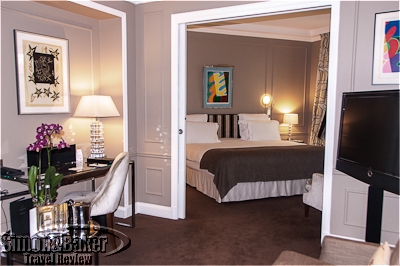
The bedroom of the Opera Suite.
Being of one mind with Lady Windermere (“I can resist anything but temptation.”), I suppose I instinctively felt it best not to venture too far into this bastion of enticing luxuries until my recent stay at Le Burgundy, a five star boutique hotel that opened in 2010 on Rue Duphot, just off Rue Saint-Honore.
Originally, the winning argument for my choice of Le Burgundy was its in house spa, complete with 15 meter (50 foot) long swimming pool, hammam and sauna, a rarity among boutique properties in Paris.
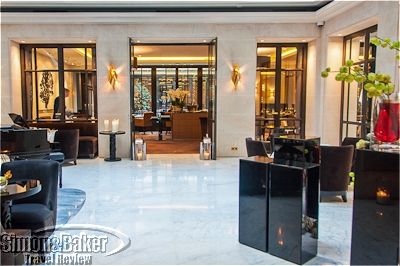
The winter garden opened onto the dining room.
That it had already garnered a solid reputation for the luxury of its accommodations and excellence of its service had only faintly registered in my awareness, until I checked in. From the warm welcome of the doorman who relieved me from my bulky carry on bag before I had even made it through the front door to the reception staff who had me settled in my suite in record time, the tone was set. The service was attentive and unobtrusive every moment of my stay.
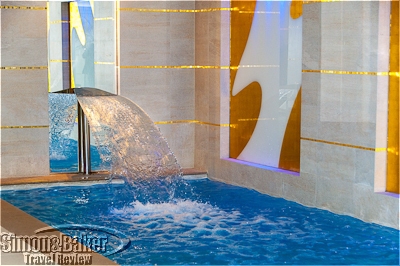
There was an arching waterfall at the far end of the pool.
My spacious second floor suite, Opera, (the eight suites were named after some of the most iconic nearby landmarks) was an intimate urban retreat decorated in an understated classic style with contemporary touches and the latest modern amenities. I especially enjoyed the vast bathroom with its top of the line whirlpool bathtub and oversized walk in shower with high pressure rain showerhead and six moveable body jets. And then, for the ultimate Parisian apartment luxury, the bedroom’s French doors opened onto an inviting private terrace surrounded by large tubs of lush shrubbery.

Place Vendome was only a few minutes’ walk from Le Burgundy
It was a pleasure to relax there between marathon visits at the nearby Musee du Louvre and Galerie Nationale du Jeu de Paume, a museum of contemporary arts.
And yes, I did enjoy window shopping around this chicest of Paris neighborhoods every time I stepped outside Le Burgundy. But beyond its privileged location and excellent accommodations and service, it was the unique indulgence of starting each day with an invigorating swim followed by a scented eucalyptus and citrus steam bath that propelled Le Burgundy to the top of my favorite Paris addresses.
by Editor | Nov 11, 2013 | Accomodations, Ecotourism, New Articles
By Laura Scheiber
Photos by Matthew Harris
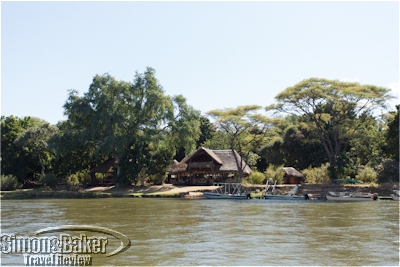
Chiawa Camp
My husband and I had high hopes that Chiawa Camp, a tented property in Zambia‘s Lower Zambezi region, would provide us a premiere safari experience based on the property’s awards and recognition. Soon after our arrival we discovered the camp, situated on a picturesque riverbank in the Lower Zambezi National Park, offered outstanding game viewing, luxury camp accommodations, and excellent cuisine and service. We also learned that Chiawa had another side. Its founders, Dave and Grant Cumings, a father and son team, participated in the fight against poaching. While staying at the camp, we had a chance to chat with Grant about how it all began.
Back in the day, Dave used to take his son Grant on bush trips, exploring east along the Zambezi River. Eventually they arrived at Chiawa’s current location and found themselves going back for repeat trips. Sleeping under the stars and surrounded by amazing wildlife and geography, they believed the spot to be a magical place, and wanted to share it with others. They started taking friends and family on trips to the area. In time, the practice evolved into photo safaris with diplomats living in Lusaka. Through some convincing and lucky contacts, the governmental parks department awarded Dave and Grant a permit to build a semi permanent camp in the Park.
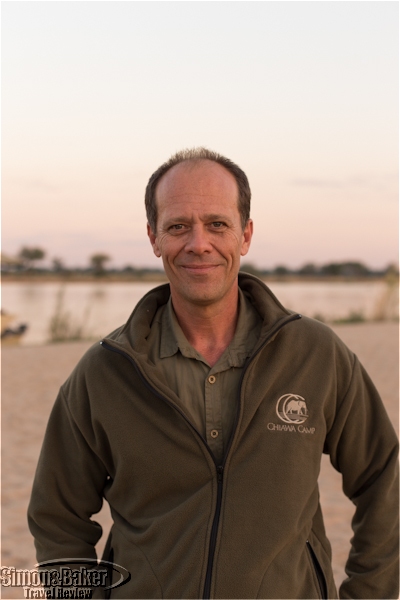
Grant Cumings, co-owner, Chiawa Camp
At first things were difficult. Zimbabwe is just on the other side of the river, and the civil war saw a lot of guerrilla activity in the region long before Chiawa’s existence. Soldiers from both sides would frequently fight on the Zambian side of the river. Eventually the conflict ceased, leaving a number of former soldiers in possession of firearms. With few opportunities to earn an income, many turned to poaching. Grant spoke poignantly of seeing his first butchered elephant as a young man, something that moved him deeply and motivated him to fight passionately for conservation.
The Cumings father and son team started to move against poachers, working with scouts to track, capture and turn them over to the authorities. It was dangerous work. To their dismay they uncovered evidence of corruption, which strongly suggested that some officials were in collusion with the poachers. On one occasion, Dave brought in a detective from Lusaka to break the poaching ring. A number of poachers were found and captured, and used rifle shells were gathered as hard evidence of poaching activity. However, the day after capture a detective said the shells had mysteriously been misplaced.
It quickly became apparent to them that the poachers had bought him off. Dave thought quickly on his feet, and in a moment of inspiration, responded that losing the shells was no problem since he had some extras (which wasn’t true). That tricked the detective into thinking that the prosecution would go ahead. During a tense showdown, the detective “found” the missing shells and the prosecution was able to proceed.
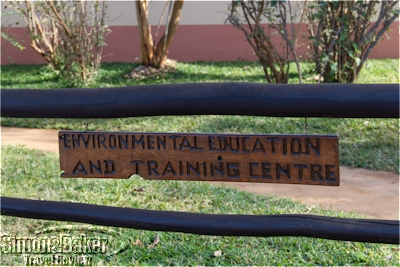
The Conservation Lower Zambezi Environmental Education Program
At the height of poaching, Grant and his team might come across 60 to 70 mutilated elephants each year, whereas now they might come across six to seven carcasses in the bush, most of them from animals that had died of natural causes. Grant and his father realized that capturing poachers was only half the story, education was also key. If poachers and the children of poachers could be made to understand that keeping those beautiful animals alive was worth more in the long run than killing them, then conservation efforts would be sustainable.
Through a serendipitous meeting with a Danish ambassador who drove into Chiawa Camp one day, Grant was able to secure Danish sponsorship and establish the Conservation Lower Zambezi Environmental Education Program.
A residential center, he explained, it strives to provide a wide variety of conservation and HIV/AIDS education to Zambians from all over the country. It also hosts the rigorous guide certification exams. The program, he said, has provided career opportunities for many locals, some of whom now work as guides at Chiawa. Grant explained that although poaching remains an ongoing battle to this day, it has significantly declined in the region thanks to the efforts of the Cumings family members and park scouts, and subsequently through Conservation Lower Zambezi, a charity they co-founded and of which Grant is a trustee and past chairman.
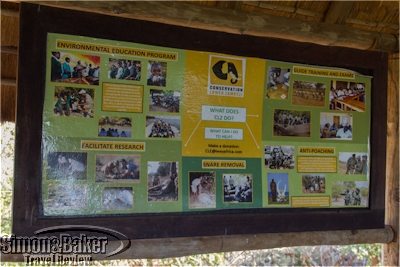
A bulletin board at the Conservation Lower Zambezi facilities
Grant’s conservation efforts are not yet done. His dream is that one day the black rhino might be introduced back into the Lower Zambezi National Park. He’s resigned to the fact that this isn’t possible just yet because they would present too tempting a target for the poachers. His hope is that over time this will change, through continued education and anti-poaching efforts.
It was a pleasure to meet Grant, an inspirational pioneer of conversation in the Lower Zambezi region. While we thoroughly enjoyed our luxury safari experience at Chiawa, what made it special was understanding firsthand the ethos of conservation that is so intricately intertwined in the history and current practices of the camp. We hope to one day return and see its continued conservation efforts evolve to preserve the natural beauty of the Lower Zambezi National Park.
by Editor | Oct 28, 2013 | Accomodations, Ecotourism, New Articles
By Laura Scheiber and Matthew Harris
Photos by Matthew Harris
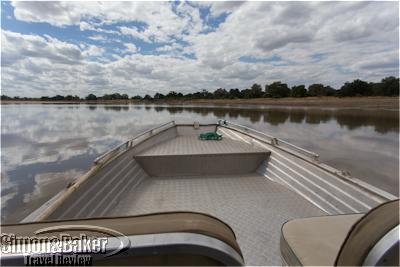
Crossing the Luangwa River
We arrived at the bank of the Luangwa River, at the end of a game viewing drive in Zambia’s South Luangwa National Park from our previous safari lodge. After loading our luggage into a small boat, we were ferried across the river by one of our hosts, Finlay Hunter. On our arrival at Chinzombo, a luxury safari camp, Finlay and his wife and cohost, Wendy offered us cool washcloths to freshen up, served us fruit cocktail drinks and made us feel at home. It was a sign of things to come. The young, energetic, professional and attentive couple went out of their way to ensure our stay was perfect.
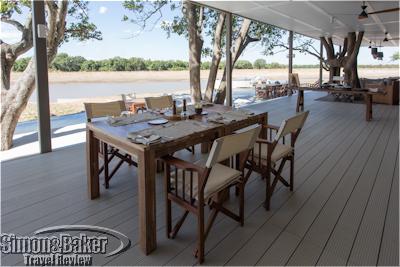
View of the Luangwa River from the dining area of Chinzombo camp
The camp, on the Luangwa riverbank opposite the beautiful South Luangwa National Park, is a one hour drive from Mufwe Airport, which is a quick hour flight to Lusaka. Being close to the national park meant that we were able to enjoy great game viewing drives and walks with our charismatic guide Shaddy Nkoma. With years of guiding experience, he provided fascinating insight into the African bush. He also regaled us with stories of his youth in Zambia including having to swim to school through crocodile infested rivers. One time he even lost his clothes in the process.
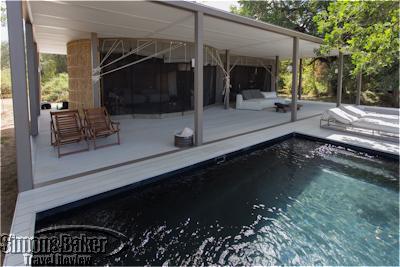
Our room with a pool view
The newly opened camp was a joy for us as guests. The architecture was modern with a nod to safari camps of old, with leather, wood and brass fittings. The handsome open bar and dining area also had a section of paraphernalia from the late Norman Carr, a safari industry veteran. In it were some wonderful prints of him with two male lions he raised from cubs.
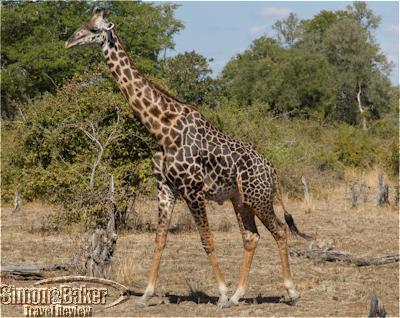
A giraffe we saw on a drive from Chinzombo camp
Our open fronted luxury tented accommodations with a personal plunge pool and views out onto the Luangwa River were superb. Amenities that made us feel pampered included bathrobes, slippers, hot water bottles the staff placed in our bed during the evening room service, and complimentary drinks in the fridge.

River viewing from the couch
The cuisine at the camp was delicious, fresh and plentiful. We especially enjoyed the sundowners and cakes served on safari drives. It was a wonderful way to watch the sunset. Chinzombo had the feel of a modern luxury boutique hotel with safari influences and access to the amazing African bush at its doorstep. We thoroughly enjoyed our contemporary safari experience.
by Editor | Jul 22, 2013 | Accomodations, New Articles, Restaurants
Article and photos by Josette King
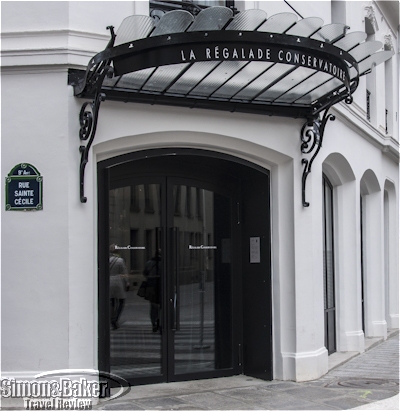
The main entrance of La Régalade
In a city that boasts more than its fair share of venerable grande dame properties, it’s luxury boutique hotels that have been creating a buzz in Paris in recent years. And few have buzzed louder than the recently opened five star Hotel de Nell. What I enjoyed most about my recent visit there was, well, everything! The location first of all, in the heart of the tony 9th arrondissement, a Right Bank neighborhood of understated side streets lined with elegant balconied buildings of quarry stone, just north of the Grands Boulevards on the way to Montmartre. Although mainly overlooked by tourists, the quietly chic 9th has been a hub of Parisian intellectual and artistic life for more than two centuries, and retains to this day its 19th century atmosphere.
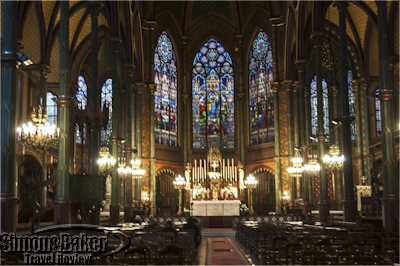
The neo-gothic Church of Saint Eugène and Sainte Cecile
One block down the street from the Hotel de Nell is the Conservatoire (music and dance academy founded in 1795) where Paris was first introduced to the music of Ludwig van Beethoven in 1828, and Hector Berlioz premiered his Symphonie Fantastique two years later. Around the corner, is the church of Saint Eugène et Sainte Cécile (Jules Verne was married there), a unique 19th century neo-gothic church, the first in Paris with its interior entirely metallic. The legendary Folies Bergères cabaret, with its 1930 Art Déco façade recently returned to its original gilded splendor, is one street over. And the place where George Sand and Frederic Chopin once lived (in separate apartments across from each other) is just a short walk away.

The newly restored façade of the Folies Bergères cabaret
I thoroughly enjoyed my leisurely exploration of the neighborhood. And I loved even more returning home to the serene luxury of the Hotel de Nell after my forays back in time to Paris’ Belle Epoque. Behind its impeccably restored 19th century façade with its lacy wrap-around wrought iron balconies, noted architect and designer Jean-Michel Vilmotte created a tranquil minimalist retreat that brilliantly combined mid-20th century-inspired furnishings with oriental details. The resulting Zen-like atmosphere permeated every corner of the property. But nowhere was it more in evidence than in my light-filled fifth story room with its romantic view of the neighborhood rooftops and its stunning bathroom with a white marble Japanese-style soaking tub and shoji screen-like unpolished glass windows.
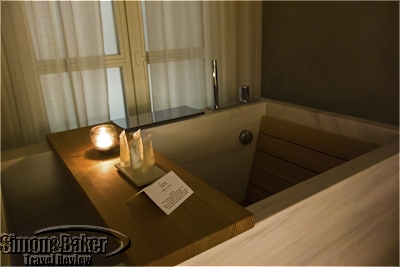
A votive candle cast a soft glow on the bathroom
Then on the street floor, there was La Régalade, one of Paris’ hot new bistros. Here Bruno Doucet, one of the city’s leading young chefs, dished out a cuisine that has become so popular in recent years that a new word had to be invented for it: bistronomy. This is where gastronomy, and the skills Chef Doucet honed in the kitchens of Pierre Gagnaire and Jean-Pierre Vitago, is translated into simpler yet imaginative, more convivial bistro fare offered as a friendly three-course prix fixe formula. Small wonder that whether for lunch or dinner, reservations were strongly recommended during the week and definitely necessary on weekends.






































